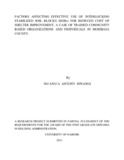| dc.description.abstract | Meeting the need for adequate housing of the world‟s population requires sustained investment and continued innovation, particularly in Appropriate Building Materials and Technologies (ABMT) that lower the cost of construction and the cost to the environment. Interlocking Stabilized Soil Block (ISSB) technology is one such technology that is gaining growing recognition in East Africa. Compared with alternatives such as fired brick, it offers lower construction costs at comparable quality, is suitable for a wide range of environments, and dramatically reduces the impact on the environment. (UN-HABITAT 2009)
Appropriate Building Materials and Technologies (ABMT) refers to building processes, materials and tools that are cost-effective, safe, innovative, green/environmentally friendly as well as acceptable to the climate, socio-economic conditions, and natural resources of an area. It uses soil as its major ingredient. This study sought to establish the factors affecting effective use of Interlocking Stabilized Soil Block for reduced cost of shelter improvement in Mombasa County. Four specific objectives guided the survey and these are: To establish how training on ISSBs affects improvement of Shelter, how access to ISSBs Equipments and Cost of transport and construction materials affects improvement of Shelter, and to establish how perception of the quality of the building blocks affects improvement of Shelter.
The literature review has outlined the history of soil technology and recognizes the fact that, earth is the oldest material used by man for the construction purposes. It indicates the efforts man has made in an effort to improve earth as a construction material such as the use of appropriate technologies like Interlocking Stabilized Soil Blocks (ISSBs)
The research was purposively to be carried out in Mombasa County in Kenya. A descriptive case study research design was used to collect primary data in addition to secondary data. Stratified simple random sampling was used to ensure representation. The data collected was analyzed in a descriptive form as well as numerically where possible. A pretested questionnaire was administered to the target population to ensure that the questions were understood equally by all the respondents. The participants were selected through stratification in terms of the groups that have been trained and thereafter simple random sampling was conducted on each group so
as to give each and every individual an equal chance of being represented in the sample. A total of 98 participants were interviewed.
The collected data was analyzed both qualitatively and quantitatively. The responses were coded and keyed in as appropriate while descriptive data is represented in tabular and graphical forms. | en |

